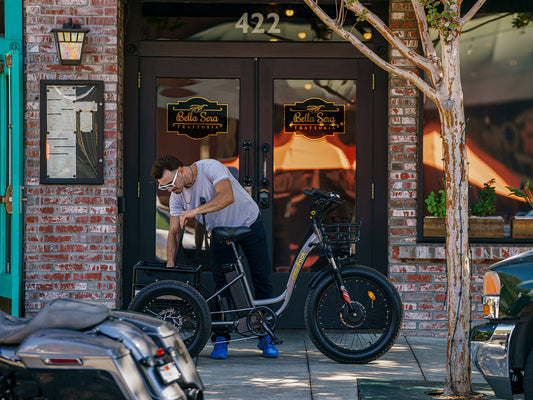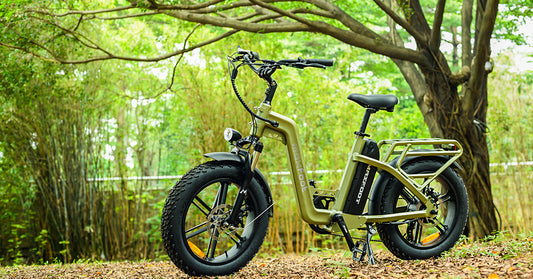Comfort on your e-bike starts with the saddle. It supports your weight, absorbs road vibrations, and helps you maintain proper posture. The wrong saddle can cause soreness, numbness, and an overall unpleasant riding experience. So, it’s quite important to find the one that matches your body and riding style.
Are you struggling with saddle discomfort on your e-bike? Do you feel the need for a saddle that enhances your riding experience?
If so, this article is especially for you. It covers all the different types and styles of an ebike saddle. The aim is to help you find the best one for your needs.
Basic Elements To Consider in an Ebike Saddle
The comfort of a saddle is based on multiple factors – from its shape and design to profile cuts and padding, every element matters. Here’s a detailed review of the different elements that make each saddle type unique:
Geometrical Shape
Saddles come primarily in “Pear” and “T” shapes; this shape can observed by looking at the top profile of the saddle.
Pear-shaped saddles have a larger surface area. They offer more room for position changes and are ideal for upright riders. However, they can cause thigh rub if too large.
T-shaped saddles have long, slender noses and sharp flare towards the back. They suit aggressive riders, particularly those performance-focused riders.
Saddle Curvature
The curvature of the saddle, both front-to-back and side-to-side, significantly affects comfort. A flat saddle is good for upright riders who like to move around in the saddle.
A curved saddle is better for maintaining control and staying centered, especially if it fits your sit bone width.
Saddle Cut-Outs
Small cutouts, often from the midpoint of the saddle up the nose, protect sensitive areas between the sit bones. They prevent numbness by safeguarding important arteries and nerves and relieve pressure, especially for female riders.
Not everyone needs them. If you're comfortable on hard surfaces, you might not need a cutout. Plus, they can be a source of significant discomfort during rainy seasons as dirt or mud may penetrate inside.
Saddle Padding
Padding in a saddle is key to comfort, especially on longer rides. It absorbs shocks and vibrations from the road. We generally see two types of padding in ebike saddles, foam and gel.
Foam Padding gives a firmer feel and can maintain its shape over time. It is preferred by riders who cover long distances as it provides consistent support.
Gel Padding is known for its plush comfort as gel conforms to the rider's body more readily. It is favored for shorter rides or for riders who need extra cushioning.
However, more padding isn't always better. Too much can lead to chafing and discomfort, particularly over long distances.
Saddle Rails
The rails connect the saddle to the bike and play a crucial role in shock absorption. They also influence the saddle's overall weight and adjustability.
The common materials for rails include steel, aluminum, titanium, and carbon.
- Steel: Durable and often the most affordable, but also the heaviest.
- Aluminum: A balance between strength and weight, offering a lighter option than steel.
- Titanium:Combines strength and lightweight properties, but usually comes at a higher price.
- Carbon:The lightest option, favored for high-performance bikes. It's also the most expensive and offers excellent vibration damping.
Saddle Cover Material
This is what you directly sit on. It needs to be durable, comfortable, and suited to your riding conditions. Synthetic materials are the most common choice as they don’t require a break-in period. They are durable and come in various textures to suit different needs.
Leather is another durable choice. It has a significant break-in period (~200 miles) but molds to the rider's shape for a custom fit. It needs regular maintenance to protect it from water and UV damage.
Gender Specifics Saddle
You may also see gender-specific saddles in the market, categorized as either male or female. This distinction is primarily based on the average sit bone width associated with each gender. Typically, women have wider sit bones due to anatomical differences. So, a wider seat is designed for them.
However, remember that the concept of an "average" body type is not always applicable to everyone. The reality is that individual body types vary significantly. So, you need to find a saddle correctly according to your body dimensions.
How to Choose The Best Saddle for Your Ebike?
Selecting the best saddle for your e-bike is a personalized process that involves understanding your body, riding style, and the terrain you will be cycling on. Here’s a road map for finding the perfect saddle:
Measure your Size
Your sit bone width is crucial for finding a comfortable saddle. Many e-bike shops offer tools for measuring sit bones, and some even provide saddle pressure mapping to identify your pressure points.
At home, you can measure your sit bones by sitting on a sheet of aluminum foil placed on a soft yet firm surface (like a cushioned chair). The indentations left on the foil will be your sit bones' marks. Measure the distance between the centers of these indentations, and convert the measurement to millimeters (mm), which is the standard in e-bike sizing.
The saddle size is the width of its widest point. Choose a saddle that's 10-20mm wider than your sit bone width, as most saddles taper off at the edges.
Identify your Riding Position
If you lean into your handlebars, mimicking road racers, a T-shaped saddle with a cutout or relief channel is likely your best bet. For those who sit upright, a pear-shaped saddle with ample gel or padding will provide the necessary cushioning for the sit bones.
Consider the Terrain you’ll be Riding On
Aggressive riders on rough terrain might need more padding than those who stick to smooth paths. However, riders on smooth paths should be wary of excessive padding, which can cause discomfort over time.
Take a Test Ride
The perfect saddle often requires a process of elimination. Don’t feel pressured to buy immediately; many shops allow saddle testing. Utilize that opportunity.
Wear your usual cycling clothes. Pay attention to pressure points and vary your riding during the test — ride fast, slow, and over bumps to evaluate the saddle's comfort.
Effect of Saddle Position
You may buy a new saddle but it may still not be effective if the saddle isn’t positioned correctly. Here are the consequences of wrong saddle positioning.
- If the Saddle is Too Low, you will experience quadriceps burn and pain in the front of your knees.
- If the Saddle is Too High, This can lead to hamstring burn, pain in the back of your knees, hips moving from side to side, and lower back pain.
- If Saddle Is Titled Forward, you will face excessive pressure in your intimate area and on your wrists, which can lead to hand numbness.
- If Saddle is Titled Backward, you will find yourself slipping backward.
- If the Saddle is Positioned Too Forward. This results in a lot of weight on your hands, quadriceps burn, and pain in the front of your knees.
- If the Saddle is Positioned Too Backward, it leads to a lot of weight on your bottom, upper hamstring burn, almost no weight on your hands, neck pain, and pain in the back of your knees.
Conclusion
Finding the right saddle for your e-bike is a tough ride. You may have to visit various bike shops and test out multiple designs before finalizing one. However, with this article as your guide, you're already on the right path.
At Maxfoot, we design our saddles to meet diverse biking and commuting needs, but we also know that one size doesn't fit all. That's why we've crafted this guide to help you find your ideal seating companion!




